Haoyue Liu
TimeTracker: Event-based Continuous Point Tracking for Video Frame Interpolation with Non-linear Motion
May 06, 2025Abstract:Video frame interpolation (VFI) that leverages the bio-inspired event cameras as guidance has recently shown better performance and memory efficiency than the frame-based methods, thanks to the event cameras' advantages, such as high temporal resolution. A hurdle for event-based VFI is how to effectively deal with non-linear motion, caused by the dynamic changes in motion direction and speed within the scene. Existing methods either use events to estimate sparse optical flow or fuse events with image features to estimate dense optical flow. Unfortunately, motion errors often degrade the VFI quality as the continuous motion cues from events do not align with the dense spatial information of images in the temporal dimension. In this paper, we find that object motion is continuous in space, tracking local regions over continuous time enables more accurate identification of spatiotemporal feature correlations. In light of this, we propose a novel continuous point tracking-based VFI framework, named TimeTracker. Specifically, we first design a Scene-Aware Region Segmentation (SARS) module to divide the scene into similar patches. Then, a Continuous Trajectory guided Motion Estimation (CTME) module is proposed to track the continuous motion trajectory of each patch through events. Finally, intermediate frames at any given time are generated through global motion optimization and frame refinement. Moreover, we collect a real-world dataset that features fast non-linear motion. Extensive experiments show that our method outperforms prior arts in both motion estimation and frame interpolation quality.
Bridge Frame and Event: Common Spatiotemporal Fusion for High-Dynamic Scene Optical Flow
Mar 11, 2025Abstract:High-dynamic scene optical flow is a challenging task, which suffers spatial blur and temporal discontinuous motion due to large displacement in frame imaging, thus deteriorating the spatiotemporal feature of optical flow. Typically, existing methods mainly introduce event camera to directly fuse the spatiotemporal features between the two modalities. However, this direct fusion is ineffective, since there exists a large gap due to the heterogeneous data representation between frame and event modalities. To address this issue, we explore a common-latent space as an intermediate bridge to mitigate the modality gap. In this work, we propose a novel common spatiotemporal fusion between frame and event modalities for high-dynamic scene optical flow, including visual boundary localization and motion correlation fusion. Specifically, in visual boundary localization, we figure out that frame and event share the similar spatiotemporal gradients, whose similarity distribution is consistent with the extracted boundary distribution. This motivates us to design the common spatiotemporal gradient to constrain the reference boundary localization. In motion correlation fusion, we discover that the frame-based motion possesses spatially dense but temporally discontinuous correlation, while the event-based motion has spatially sparse but temporally continuous correlation. This inspires us to use the reference boundary to guide the complementary motion knowledge fusion between the two modalities. Moreover, common spatiotemporal fusion can not only relieve the cross-modal feature discrepancy, but also make the fusion process interpretable for dense and continuous optical flow. Extensive experiments have been performed to verify the superiority of the proposed method.
CoSEC: A Coaxial Stereo Event Camera Dataset for Autonomous Driving
Aug 16, 2024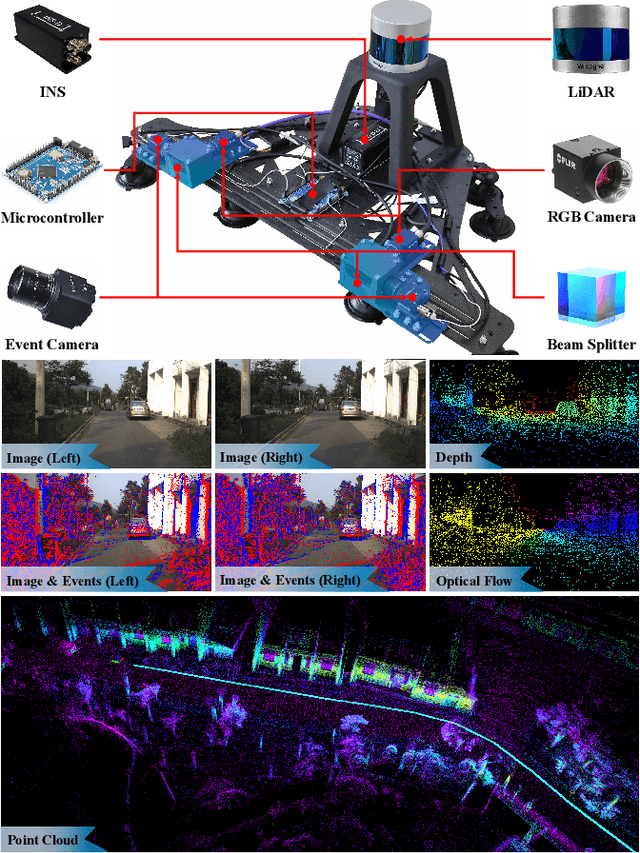
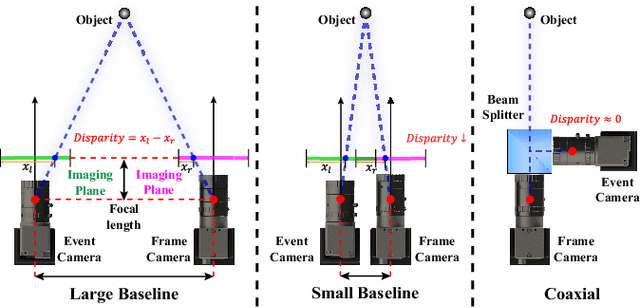
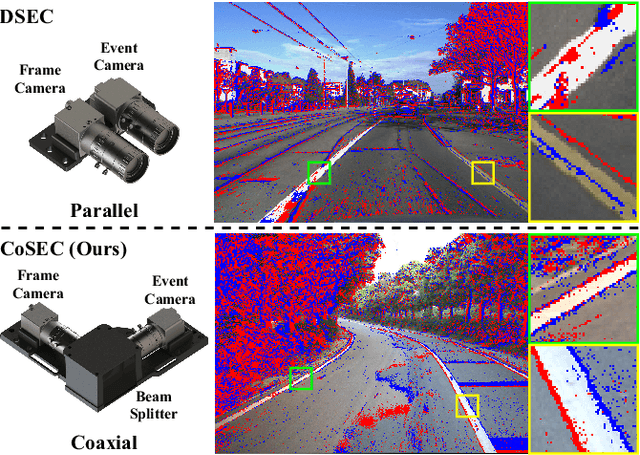
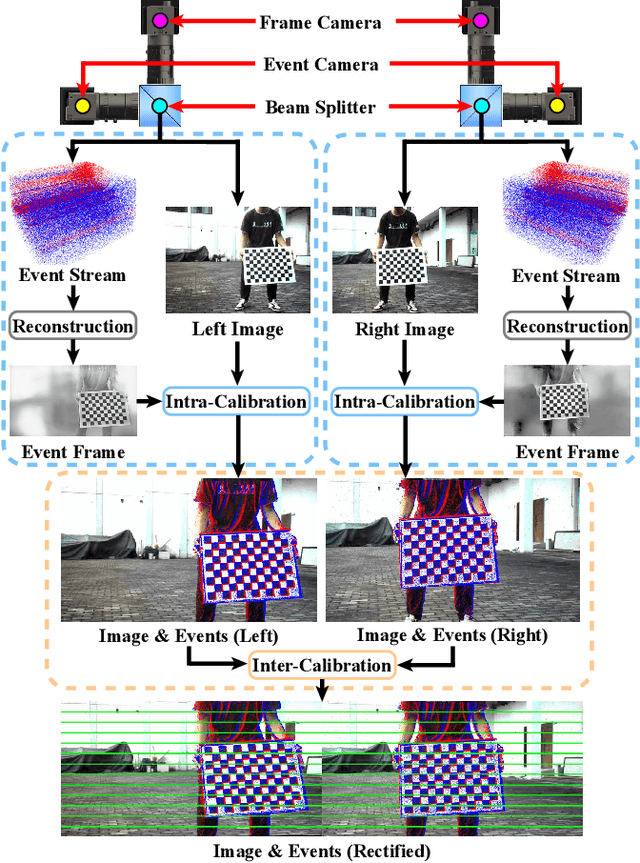
Abstract:Conventional frame camera is the mainstream sensor of the autonomous driving scene perception, while it is limited in adverse conditions, such as low light. Event camera with high dynamic range has been applied in assisting frame camera for the multimodal fusion, which relies heavily on the pixel-level spatial alignment between various modalities. Typically, existing multimodal datasets mainly place event and frame cameras in parallel and directly align them spatially via warping operation. However, this parallel strategy is less effective for multimodal fusion, since the large disparity exacerbates spatial misalignment due to the large event-frame baseline. We argue that baseline minimization can reduce alignment error between event and frame cameras. In this work, we introduce hybrid coaxial event-frame devices to build the multimodal system, and propose a coaxial stereo event camera (CoSEC) dataset for autonomous driving. As for the multimodal system, we first utilize the microcontroller to achieve time synchronization, and then spatially calibrate different sensors, where we perform intra- and inter-calibration of stereo coaxial devices. As for the multimodal dataset, we filter LiDAR point clouds to generate depth and optical flow labels using reference depth, which is further improved by fusing aligned event and frame data in nighttime conditions. With the help of the coaxial device, the proposed dataset can promote the all-day pixel-level multimodal fusion. Moreover, we also conduct experiments to demonstrate that the proposed dataset can improve the performance and generalization of the multimodal fusion.
Seeing Motion at Nighttime with an Event Camera
Apr 18, 2024



Abstract:We focus on a very challenging task: imaging at nighttime dynamic scenes. Most previous methods rely on the low-light enhancement of a conventional RGB camera. However, they would inevitably face a dilemma between the long exposure time of nighttime and the motion blur of dynamic scenes. Event cameras react to dynamic changes with higher temporal resolution (microsecond) and higher dynamic range (120dB), offering an alternative solution. In this work, we present a novel nighttime dynamic imaging method with an event camera. Specifically, we discover that the event at nighttime exhibits temporal trailing characteristics and spatial non-stationary distribution. Consequently, we propose a nighttime event reconstruction network (NER-Net) which mainly includes a learnable event timestamps calibration module (LETC) to align the temporal trailing events and a non-uniform illumination aware module (NIAM) to stabilize the spatiotemporal distribution of events. Moreover, we construct a paired real low-light event dataset (RLED) through a co-axial imaging system, including 64,200 spatially and temporally aligned image GTs and low-light events. Extensive experiments demonstrate that the proposed method outperforms state-of-the-art methods in terms of visual quality and generalization ability on real-world nighttime datasets. The project are available at: https://github.com/Liu-haoyue/NER-Net.
Exploring the Common Appearance-Boundary Adaptation for Nighttime Optical Flow
Jan 31, 2024



Abstract:We investigate a challenging task of nighttime optical flow, which suffers from weakened texture and amplified noise. These degradations weaken discriminative visual features, thus causing invalid motion feature matching. Typically, existing methods employ domain adaptation to transfer knowledge from auxiliary domain to nighttime domain in either input visual space or output motion space. However, this direct adaptation is ineffective, since there exists a large domain gap due to the intrinsic heterogeneous nature of the feature representations between auxiliary and nighttime domains. To overcome this issue, we explore a common-latent space as the intermediate bridge to reinforce the feature alignment between auxiliary and nighttime domains. In this work, we exploit two auxiliary daytime and event domains, and propose a novel common appearance-boundary adaptation framework for nighttime optical flow. In appearance adaptation, we employ the intrinsic image decomposition to embed the auxiliary daytime image and the nighttime image into a reflectance-aligned common space. We discover that motion distributions of the two reflectance maps are very similar, benefiting us to consistently transfer motion appearance knowledge from daytime to nighttime domain. In boundary adaptation, we theoretically derive the motion correlation formula between nighttime image and accumulated events within a spatiotemporal gradient-aligned common space. We figure out that the correlation of the two spatiotemporal gradient maps shares significant discrepancy, benefitting us to contrastively transfer boundary knowledge from event to nighttime domain. Moreover, appearance adaptation and boundary adaptation are complementary to each other, since they could jointly transfer global motion and local boundary knowledge to the nighttime domain.
1st Solution Places for CVPR 2023 UG$^2$+ Challenge Track 2.2-Coded Target Restoration through Atmospheric Turbulence
Jun 15, 2023Abstract:In this technical report, we briefly introduce the solution of our team VIELab-HUST for coded target restoration through atmospheric turbulence in CVPR 2023 UG$^2$+ Track 2.2. In this task, we propose an efficient multi-stage framework to restore a high quality image from distorted frames. Specifically, each distorted frame is initially aligned using image registration to suppress geometric distortion. We subsequently select the sharpest set of registered frames by employing a frame selection approach based on image sharpness, and average them to produce an image that is largely free of geometric distortion, albeit with blurriness. A learning-based deblurring method is then applied to remove the residual blur in the averaged image. Finally, post-processing techniques are utilized to further enhance the quality of the output image. Our framework is capable of handling different kinds of coded target dataset provided in the final testing phase, and ranked 1st on the final leaderboard. Our code will be available at https://github.com/xsqhust/Turbulence_Removal.
G$ \mathbf{^2} $VD Planner: An Efficient Motion Planning Approach With Grid-based Generalized Voronoi Diagrams
Feb 01, 2022



Abstract:In this letter, an efficient motion planning approach with grid-based generalized Voronoi diagrams is newly proposed for mobile robots. Different from existing approaches, the novelty of this work is twofold: 1) a new state lattice-based path searching approach is proposed, in which the search space is reduced to a Voronoi corridor to further improve the search efficiency, along with a Voronoi potential field constructed to make the searched path keep a reasonable distance from obstacles to provide sufficient optimization margin for the subsequent path smoothing, and 2) an efficient quadratic programming-based path smoothing approach is presented, wherein the clearance to obstacles is considered in the form of the penalty of the deviation from the safe reference path to improve the path clearance of hard-constrained path smoothing approaches. We validate the efficiency and smoothness of our approach in various challenging simulation scenarios and large-scale outdoor environments. It is shown that the computational efficiency is improved by 17.1% in the path searching stage, and smoothing the path with our approach is 11.86 times faster than a recent gradient-based path smoothing approach. We will release the source code to the robotics community.
A Deep Learning Inference Scheme Based on Pipelined Matrix Multiplication Acceleration Design and Non-uniform Quantization
Oct 10, 2021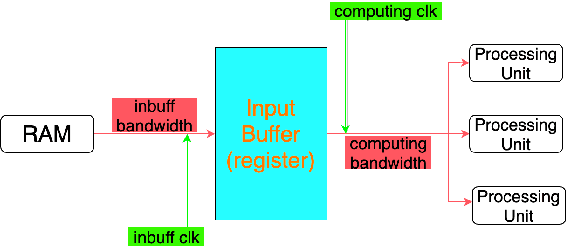
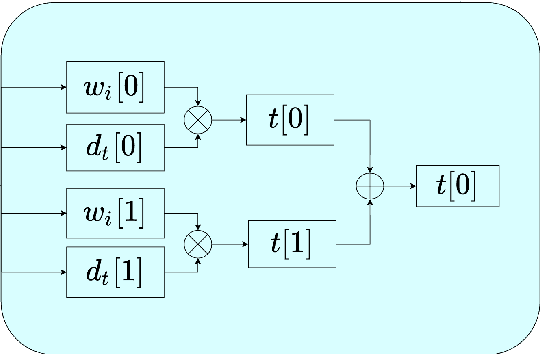
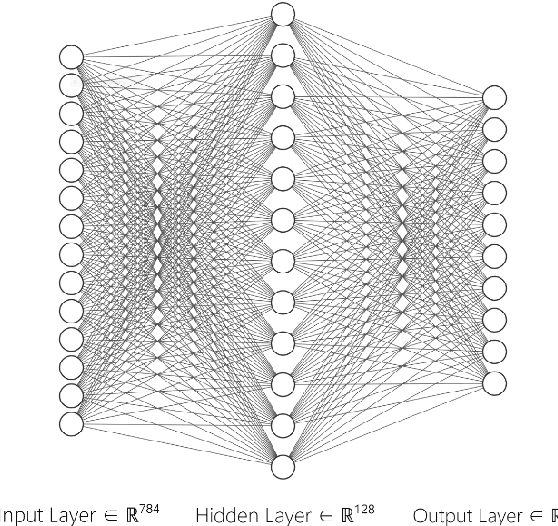
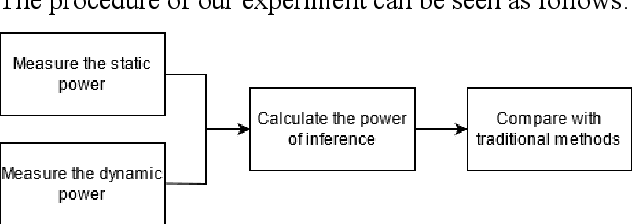
Abstract:Matrix multiplication is the bedrock in Deep Learning inference application. When it comes to hardware acceleration on edge computing devices, matrix multiplication often takes up a great majority of the time. To achieve better performance in edge computing, we introduce a low-power Multi-layer Perceptron (MLP) accelerator based on a pipelined matrix multiplication scheme and a nonuniform quantization methodology. The implementation is running on Field-programmable Gate Array (FPGA) devices and tested its performance on handwritten digit classification and Q-learning tasks. Results show that our method can achieve better performance with fewer power consumption.
 Add to Chrome
Add to Chrome Add to Firefox
Add to Firefox Add to Edge
Add to Edge